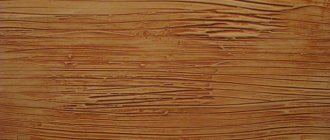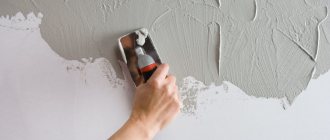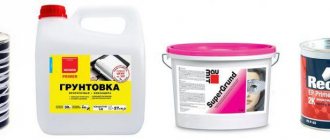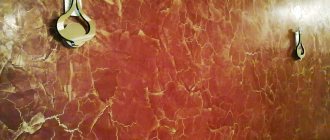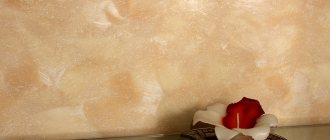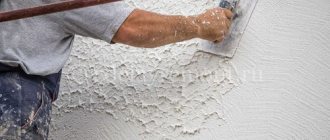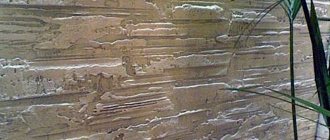Features and purpose
Wall wax can be used in conjunction with various types of plasters - regular finishing plasters, Venetian plasters, bark beetle plasters, and fleece plasters. The main purpose of its application is to create a water-repellent coating on plaster, which itself is prone to absorbing moisture. In addition to enhancing the moisture resistance of the finish, the product also performs other functions:
- extends the service life of plaster;
- improves appearance;
- gives matte or gloss;
- allows you to change the color of the base.
Coating with wax improves the appearance of decorative plaster.
Using wax, you can create interesting tonal transitions on the wall, make a drawing, and change the texture of the finish. The compositions are made on the basis of acrylic copolymers, natural waxes, various modifiers and fillers. Due to the absence of harmful components, they can be used in any room, even in children's rooms. In addition, the products are vapor-permeable and do not disturb the natural air exchange in the house, so a healthy microclimate will remain.
Description
Wax for decorative plaster is a protective and finishing material made on the basis of natural beeswax or its synthetic analogue. After hardening and polishing, it turns into a film that guarantees the durability and beauty of the plaster underneath.
Wax is used at the final stage of finishing, giving it completeness because:
- favorably highlights its structure;
- gives a mirror shine or matte finish;
- makes the drawing clearer.
In addition, the wax coating protects the plaster from moisture and mechanical damage, and, if necessary, is used to give it the desired shade.
Types of compositions
Wax for plaster can be natural or synthetic. We are talking about its base: in natural materials, its role is played by beeswax or palm wax, which gives the finish a unique shine. Such compositions are hypoallergenic, but have a shorter service life than artificial ones. The latter are produced industrially from safe components. Synthetic products are practically impervious to moisture, temperature changes, wear-resistant and do not require frequent renewal of the layer.
Art Wax Optimist for Venetian plaster
Depending on the structure, all waxes can be divided into:
- liquid - easy to apply with a brush, quickly fills even the smallest pores of the base, ideal for highly porous, rough surfaces;
- thick - more suitable for smooth materials, for example, plaster with imitation marble, granite.
Depending on the color scheme, wax for Venetian plaster can also be chosen from a variety of options. Here are their main types:
- Transparent. They provide the finish with shine, a beautiful gloss, or give a soft silky effect. Usually used on plaster that has already been complexly painted or “stone”.
- Colored. They help change the tone of the base itself or color a colorless coating. Compositions of different brands are available in rich color variations.
- With decorative admixtures. The most popular are waxes with gold or silver dust. They are used to imitate gilding, silvering, and to give the coating a beautiful metallic sheen.
Colorless wax composition for walls
How to Apply Wax to Venetian Plaster
Venetian plaster is a relatively new decorative coating containing stone dust and marble particles. This coating gives the walls the effect of natural stone of valuable species.
The use of such plaster allows you to introduce some stylistic solutions into the renovation of a room that require thorough and fundamental finishing, without spending a lot of money on the purchase of natural stone.
In addition, walls covered with plaster retain the warmth and comfort of the house. And with proper and proper protection, the marble pattern on the walls will delight you for many years.
In order for the skillful pattern to last on the walls for a long time and maintain its original appearance for several years, and maybe even decades, it is necessary to take care of the protective material.
Plaster wax copes best with this task. It creates a light, thin, shiny film on the surface, which prevents fading, burning out and protects the decorative coating from dust and possible accidental damage.
We recommend: Nuances and features of sealing drywall joints
Important! A thin layer of wax will give the plaster beauty, practicality and durability
Wax for Venetian plaster: types and differences
There are many treatment compounds on the market. Some of them require professional application skills, others are quite simple and economical. To choose the best option, consider the types of wax for protecting Venetian plaster:
• gel-wax: has a covering power suitable for hard surfaces and dense layers of plaster,
• liquid solution: suitable for fragile, porous surfaces, creates a thin protective layer and is quickly absorbed,
• for a glossy shine, you can pay attention to natural compositions based on beeswax, such mixtures contain a large amount of water and natural ingredients,
• a matte and discreet shine to the surface is given by synthetic solutions consisting of polymer compounds that are more resistant to indoor use and dirt,
• based on style considerations, you can use both transparent and colored wax for plaster if the surface needs tinting or color correction.
The cost of a protective coating depends not only on the volume of material, but also on the components included in the composition, the name of the manufacturer, the equipment and raw materials used by him.
Important note! It is better to purchase products from European manufacturers; their quality is beyond praise, although the cost is quite high.
You should not skimp on the finishing solution, since it determines the overall impression of the repair and how practical and durable the coating will be.
Nuances and features of the application process
It is necessary to apply wax for decorative plaster after the surface has completely dried.
Important! If the plastered wall has already been standing for some time after drying, it is worth cleaning the surface of dust and dirt. A vacuum cleaner with a soft brush will do the best job for this task. Use gentle and gentle movements to collect dust, being careful not to damage the coating!
Many craftsmen, of course, have their favorite techniques, thanks to which they apply wax for decorative plaster in an even and smooth layer. If you doubt your skills, it is better to entrust this work to a professional, so you can be confident in the quality and durability of the result.
However, applying wax to dried plaster yourself is quite possible if you have enough time and patience.
Main stages:
1. Allow the surface to be treated to dry completely,
2. if necessary, clean the plastered area from dirt,
3. Prepare a convenient tool; many wax manufacturers recommend using a trowel, however, without sufficient skills, it will be quite difficult to handle it. Therefore, we recommend using a rubber spatula. This is a simpler and more flexible tool that will allow you to evenly distribute the protective layer.
4. Apply the composition, starting with small areas, having processed one, move on to the next, moving along the surface of the wall.
Important! To avoid unnecessary seams and irregularities on the surface, treat the entire surface or at least 1 wall at a time.
5. Once application is complete, take a soft, lint-free cloth and gently rub the surface until shiny.
Remember that all blemishes can be removed within 4 hours after application. Too thick a layer of the composition can be easily removed with a cloth, and already hardened areas can be cleaned with a rag moistened with white sprit.
In order to give the walls the desired shade, use colored compounds. Transparent mixtures are suitable for complex or ideally colored surfaces.
To perform all steps continuously, stock up on enough material.
Depending on the porosity of the surface and the composition of the plaster, wax consumption may vary. However, as a rule, it does not exceed 50-80 grams per 1 square meter.
If all the work is done correctly and accurately, then thanks to decorative Venetian plaster the wall will look as if it was decorated with natural marble, and the use of gold-plated solutions will give a luxurious and festive look to the surface.
Choosing wax for different surfaces
When purchasing a waxing product, you should pay attention to its compliance with the specific type of plaster in terms of performance characteristics. For example, Venetian is applied in several layers, giving it a special stone or antique appearance. Wax should only highlight the beauty of the walls, and not drown it out, so in this case it is worth choosing a transparent composition with moderate shine.
Dull, monochromatic coatings with a matte texture can be decorated using wax with bronze dust or gold plating. The same effects are ideal when applying Moroccan plaster. There are compositions specifically designed for decorating walls in a vintage style - they give them a cracked look, working like craquelure varnish. When choosing wax for the bathroom, kitchen, toilet, you need to pay attention to moisture resistance - the indicator should be maximum.
Decorative plaster coated with wax and gilded
Tinting
Most often, during construction and renovation, colorless wax is purchased, especially for coating the Venetian. But sometimes you need shades that are not produced or are out of stock, so tinting is used. This is the process of coloring the mass. It is done independently or using a computer at the place where the material was purchased.
The wax is tinted with special pigment pastes. At home, you have to determine the ratio of dye and base yourself. There is a risk that the desired shade will not be obtained. Computer tinting is accurate due to the determination of the exact amount of pigment. To do this, use a color formula. The process of its creation is controlled by software.
At the point of purchase, the jar of wax is placed into a dosing machine. The precise addition of colorants occurs. Next, the mixing device works to ensure color uniformity.
Protective paraffin wax for the Venetian is chosen transparent to simply add smoothness and protect the surface.
Cost and quality
The price of the product greatly depends on the manufacturer and the components included in the composition. It can be 400-5500 rubles per liter. For example, waxing material from the Russian brand “VGT” costs 450 rubles/liter, Swedish Parade Ice Venezia Wax costs about 1,100 rubles, and Cera di Veneziano material costs 5,450 rubles.
Protective wax Parade Ice Venezia Wax
You should not buy waxes that are too cheap - they may be of poor quality and therefore will not last long. Normally, the coating should be renewed once every 4-5 years, and low-grade compounds sometimes lose their attractiveness and protective properties after just a year. Also, when purchasing, you need to pay attention to environmental friendliness and the absence of allergic components in the composition.
Application of protective and decorative coating
To cover a wall with a wax composition yourself, without turning to a specialist for help, you will need to put in a lot of effort and effort. Wax application consists of several stages:
- Coating.
- Smoothing.
- Treatment with a damp cloth.
- Processing with a spatula.
- Hardening of the coating.
The ready-made or self-made mixture is applied to the surface to be treated using a sponge or construction thread roller. Another sponge, which should first be moistened with water, will be used to smooth out the wax composition. This stage is continued until spots or denser layers appear. The coating must be allowed to dry slightly for 15 minutes. Then the surface is treated with a white rag slightly moistened with water. This is necessary in order to reduce the risk of unwanted color stains. If wax is applied incorrectly, buildup can occur in the inner corners. To prevent this from happening, it is recommended to re-sand the corners using a putty knife wrapped in a white rag. To evenly distribute the wax composition, treat the surface with circular, leisurely movements. At the end of the work, the protective layer will have to dry for 4-5 hours. If desired, and to create an additional glossy effect, you can apply acrylic paint in pearlescent or any other color.
Thus, the use of wax is an important step in interior decoration. Wax has not only decorative, but also protective properties, extending the service life, so without it, the treated surface will lose its original attractive appearance. With diligence and thoroughness, applying it yourself will not be difficult, and the finished result will be no worse than the result of the work of a professional.
Waxing process
Before working with the product, you must carefully prepare the surface with the plaster applied to it (the latter must be completely dry). Remove dust from the base, preferably using a vacuum cleaner. The plaster should not have holes or other defects - after completing the wax layer it will be impossible to correct them.
Liquid compositions can be applied with a soft flannel cloth or cloth napkin; for thick ones, you should purchase a rubber spatula. It is necessary to immediately buy a sufficient amount of base material: its consumption is 50-80 g/sq.m. m per layer.
Applying a thick composition using a spatula
. Wax that is too thick can be diluted a little with water by preheating it near a radiator or in a water bath. It is important that the volume of water does not exceed 3% of the base. The composition is applied more softly and pliably to the primed plaster, and priming is also carried out using wax (4 parts of water are added to 1 part). The primer must be allowed to dry thoroughly.
Application and polishing
The wax is applied so that its layer rises slightly above the surface and fills all the depressions and holes in the plaster. Do this continuously: then all areas will be evenly colored. A beginner should invite an assistant to wax large surfaces. It is better to apply the product from the corner, moving along the wall.
After application, rub the composition over the base with a slightly damp sponge, and then rub in with a soft cloth until shine appears. Excess unabsorbed product is immediately washed off. If the technique involves tinting the cracks with dark wax, on the contrary, they do not touch the composition that filled them: then the relief will be more distinct. To enhance shine, polish the walls with a sanding machine with a special attachment. The wax drying time is 12-14 hours, complete drying occurs after 7 days.
Polishing Venetian plaster
Error correction
It happens that the composition is applied unevenly, and stripes and spots become noticeable on the surface. It is advisable to correct the mistake immediately, while the material has not yet set. It is enough to moisten a cloth with water, remove excess or add a little wax, and then polish the surface.
Sometimes flaws are noticed later, after 4-7 hours, when the wax is already partially hardened. In this case, you should warm up the problem area with a hairdryer, wet a cloth with hot water and wipe the wall. To remove dense hardened deposits, you can use a solvent. If wax has accumulated in the inner corners of the walls, it is permissible to wrap a white rag around the putty knife and sand these areas again.
How to remove the wax layer
A layer of product that is too thick and has not yet hardened can be washed off with regular hot water using a soft cloth.
Difficult areas are wiped with white spirit or another solvent. Dried wax is removed by sanding with fine-grained sandpaper using a sanding machine or sponge. Then remove dust and remaining composition with a vacuum cleaner.
Error correction
Sometimes mistakes are made when performing any work.
When waxing, there can be two options when an error is noticed:
- the applied layer has not hardened,
- the layer has time to harden (usually 5-7 hours from the moment of application).
In the first case, the error can be corrected relatively easily. For example, if you notice that the layer of wax coating is applied unevenly, then with a clean cloth moistened with water (if the composition is natural) or solvent (in the case of a synthetic substance) you can remove the excess, and where the wax material is missing, you can add it.
If the wax layer has hardened, you can try to heat the problem area with a hairdryer, wet the cloth with hot water and try to wipe off the excess. Another way is to use a solvent.
If the layer of wax somewhere is not shiny enough, you can try to bring it to a shine with a sander with a fur disc. After the wax layer has hardened, it is difficult to correct the error so that it is unnoticeable.
DIY wax recipe
High-quality products are quite expensive, and it is not always possible to decorate the entire room with them. In this case, there is the option of making your own composition for finishing the plaster.
Soap based wax
This product is prepared from ordinary toilet soap. A 150 g piece is planed on a grater with large holes, then poured with 7 liters of boiling water and brought until completely dissolved. Separately, dilute 2 teaspoons of soda in a small amount of water and add to the soap solution. Whisk the mixture and leave until it cools. Afterwards the wax is ready for application.
The wax composition can be prepared from soap and soda
Composition based on natural wax
You need to prepare the following ingredients:
- 2 parts beeswax (can be replaced with paraffin);
- 1 part purified turpentine;
- 1 part flaxseed oil;
- any pigments (if needed).
The wax is cut and melted in a water bath. Add the remaining components, use a whisk to make the mixture homogeneous, allow to cool and use as intended.
Beeswax for preparing a natural protective composition
Wax based wallpaper glue
Wallpaper glue is diluted in advance according to the instructions. Leave it for half an hour, strain to eliminate the presence of lumps. Add 1 part acrylic varnish and ½ part any decorative paint to 2 parts glue. Mix the composition well and apply it to the plaster like regular wax.
If the finish is planned to be colorless, paint may not be added.
What is the material
Everyone is familiar with beeswax. It is used in a variety of fields, from cosmetics to construction.
This substance has a number of useful properties:
- is a natural substance with a fairly high density;
- does not dissolve upon contact with water, acids and alcohols;
- melts at a temperature of about +68ºC;
- When heated, the material becomes plastic.
Before use, the substance is melted to eliminate foreign impurities and natural inclusions.
Wax, when applied to plaster, creates a very interesting effect, adding shine and at the same time aging the coating. The substance seems to tint the surface. After its application, a thin layer of film is formed on the material, and it will be impossible to change the plaster underneath without damaging the coating, so the choice of wax must be carefully approached.
Composition of natural wax in%:
- fatty acids - 14;
- alkanes - from 11 to 13;
- polyesters - up to 75;
- high molecular weight alcohols - from 1 to 1.25.
How to replace wax composition
You should not leave the plaster without a finishing coat, especially in damp rooms. She will not receive proper protection and will not acquire the most attractive appearance. If applying wax is not possible for any reason, it can be replaced with varnish. The latter performs similar functions:
- preserves the beauty of the finish and the brightness of the colors for a long time;
- protects against the influence of negative factors;
- protects from getting wet;
- provides shine.
Acrylic finishing varnish MelStrom for decorative coatings
Typically, water-based acrylic varnishes are used for processing plaster. They are environmentally friendly and suitable for interior work.
It is important that the composition is vapor-permeable and moisture-resistant, otherwise it will not last long and will disturb the microclimate in the house. Most varnishes dry in 3 hours. They can be not only glossy, but also matte, and are also sold in colored versions, with a metallic sheen and other additives.
Kinds
When using wax on Venetian plaster, the basic scale of finishing is specified. The finishing layer is:
- transparent;
- colored;
- with different inclusions.
The transparent composition helps to emphasize the texture of the finish. After processing, a glossy shine appears and looks good on a natural stone surface.
Colored wax gives the treated base an additional shade. You can adjust the main color when it turns out not to be as successful as expected. Golden, silvery shades are used for gilding, metallic effect - suitable for medieval styles. You can add construction gold, bronze, or silver powder to regular wax to give the surface original highlights.
There are two types of compositions for walls in accordance with the criteria - thickness and composition:
- Gel or liquid consistency. Liquid mixtures are used for more porous materials. They are well distributed over uneven surfaces, fill voids, and create protection. Gel wax is thicker and is used for smooth walls, for example under stone. It is not so easy to apply, but the stone finish begins to shine like a mirror, like polished marble.
- Natural or synthetic composition. Wax with natural ingredients is usually a beekeeping product with good properties - safety, absence of harmful impurities, beautiful shine. Synthetic masses are produced industrially; compared to natural ones, they are more resistant to moisture and temperature fluctuations, the service life is longer, and a dense impermeable layer with a matte effect is formed on the surface. The synthetic composition is better combined with structural surfaces.
We recommend: Venetian plasters
The varnish must be moisture resistant and vapor permeable. Drying time – 3 hours. Varnishes can be matte, glossy, colored, or with a metallic sheen.
Natural wax
What to replace
The plaster should not be left completely without a final coating, especially in a room with high humidity. The finish will not have the necessary protection.
When wax has to be abandoned, it is replaced with varnish. It plays a similar role - it preserves the attractiveness of the finish longer and adds shine. Acrylic or water-based compositions are suitable for plaster. They are environmentally friendly and are used for work inside buildings.
Wax reviews
According to the masters, the advantages of wax are difficult to overestimate. After waxing, the surfaces look expensive and elegant. With the right color selection, the room will be even more stylish and attractive. In reviews, users note that after applying wax, walls do not deteriorate from water or constantly high air humidity. Housewives like that it is easy to care for such surfaces - they can simply be washed with a cloth.
Having chosen decorative plaster for finishing your house, you should immediately think about protecting it and applying the finishing coat. Ideally, it would be wax: this material is very beautiful, reliable and lasts for many years!
How to wash off and remove the wax layer
The thick wax layer that has not yet hardened is washed off with hot water or a solvent. Pieces of fabric are used for this. You can use white spirit to wash off - a solvent designed to remove primers from wooden surfaces.
Before using any of the suggested methods, practice in a corner of the wall or any other inconspicuous place. Only after making sure that the main finish will not be damaged, start working with large volumes.
You can remove the dried wax film from a smooth coating/Venetian by sanding with fine-grained sandpaper. Use a sander with sandpaper or a sanding sponge, which is used to evenly sand off the film from the entire wall. Then the dust is removed. The surface of the Venetian is covered with a thin layer of plaster, which has a color close to the previous coating. The layer immediately becomes shiny. Dry and wax again.
Waxing requires certain skills that are quickly acquired during work. All worries, labors and worries are redeemed by the amazing quality of the coatings, the colors of which do not fade over the years, and the shine gives the house a festive and luxurious feel.
Decorative plaster: modifications
- Structural
After application it becomes grainy. This type of coating is considered the lightest. The composition includes: potassium silicate, latex and lime. The grainy effect is achieved through special additives, including particles of mica, quartz, and small stones. The degree of image depth is directly proportional to the diameter of the constituent additives.
Using this type you can achieve the effect of antique stone, leather, silk, etc. It all depends on the tools and techniques used to create the image. The coating contains resin inclusions and wax, and it is from their presence that the pattern is fixed.
After application, the walls take on the appearance of marble. This type of plaster has existed since the ancient times of Ancient Rome. To achieve the marble effect, slaked lime, marble flour, and an emulsifier were added to the composition. The last component makes the mixture thick.
Pieces of colored acrylic were added to it, thanks to it you can achieve the effect of suede, metal, velor. Before work, you need to treat the wall with an acrylic base.
Using this type, you can achieve a similar effect as when working with your own hands, however, in this case, all the boundaries will look more concise. The composition includes paints with which the image is created, small particles. Each modification of plaster has a specific application method. The simplest, as mentioned above, is structural plaster.
What to paint: choice of materials and tools
You can choose both interior and exterior paints. The manufacturer of decorative plaster always indicates on the packaging with the solution which paint is best combined with it. These can be acrylic, silicate, silicone or water-based paints. It is best to select the finishing material according to the type of decorative material. If the decorative plaster is silicate-based, then it is better to use the same paint.
As a standard, it is recommended to use materials from the same manufacturer. There are times when products from different manufacturers do not combine well, resulting in paint peeling within a couple of years after application.
You also need to be careful with the amount of paint you use so you don’t have to go to the store twice. Painting decorative plaster with your own hands is always carried out in two stages. However, paint cans usually indicate consumption per coat. You need to be careful and remember that you need two layers. By the way, if you literally lack 100 ml of paint in terms of footage, you can dilute it with water. It is usually recommended to add water in an amount of 10% of the total paint weight. There are always instructions on this account on the bank.
Applying paint with a sponge helps to develop and accentuate coatings with different textures
The following tools may be required when working:
- wide brush – for small areas and hard-to-reach places;
- roller - a classic option for large volumes of work;
- special mitten - for Venetian plasters;
- rubber sponge - to reduce contrast;
- wide spatula - the glaze composition for decorative plaster is applied in the thinnest layer.
Homemade wax for candles
You can buy ready-made wax at beekeeping stores - it is usually sold in stick form. An alternative option is to use bee wax. That is, let’s say you buy honey in honeycombs, eat it, and don’t throw away the remaining chewed wax, but collect it - once you have collected a sufficient amount, you can melt and cast candles with your own hands.
Wax for a “homemade” candle can be paraffin wax, natural bee wax, soy wax, or bean wax. Old, unburned candles are also suitable as raw materials. Where can I get wax to make a candle?
General information
Features and purpose
Wax for treating walls is used together with different types of plasters - with standard finishing plasters, or Venetian ones like “bark beetle” and “fleece”. The main purpose of application is to create a coating with water-repellent properties on plaster, which itself has a tendency to absorb moisture.
In addition to enhancing the moisture resistance of the finishing layer, the product will perform the following functions:
Increases the service life of plastered walls.- Makes the appearance of the coating even better.
- Gives gloss or matte finish.
- Allows you to change the shade/color of the base.
Using wax, you can create unusual tonal transitions on the surface of the walls, make a drawing, change the finishing texture. The compositions will be made on the basis of acrylic-type copolymers, natural varieties of wax, various modifiers and fillers. Due to the absence of harmful components, they can be used in all rooms, even children's rooms. In addition, the products are vapor-permeable and will not disrupt the natural exchange of air in your home, and therefore you will maintain a healthy microclimate.
Types of compositions
Wax for plastered surfaces can be of synthetic or natural origin. Here we are talking about the base - in natural components, its role will be played by palm or beeswax, which gives the finish an unusual shine. Such compositions are hypoallergenic, but have a shorter service life than artificial ones. The latter are made industrially from non-hazardous components. Synthetic-type products are almost impervious to moisture, temperature changes, wear resistance and do not require frequent renewal of the layer.
Depending on the structure, all funds can be divided into the following types:
- Liquid - they are easy to apply with a brush, they quickly fill even the smallest pores of the base, ideal for highly porous and rough surfaces.
- Thick - more suitable for smooth materials, for example, plaster with imitation granite and marble.
Depending on the color scheme, wax for Venetian plaster can be chosen from a large number of options. Here are the main varieties:
- Transparent - they provide the finish with shine, an unusually beautiful gloss, or give a soft silky effect. Usually used on plaster that has already been complexly painted or imitated stone.
- Colored - help change the tone of the base or color colorless coatings. Products from different manufacturers are produced in excellent color variations.
- With decorative additives - the most popular are waxes with silver or gold dust. They are used to imitate silvering, gilding, and also to give the coating an unusual metallic sheen.
Now a little about how to choose a product for different surfaces.
Why paint?
A roller with a wide pile is well suited for painting porous surfaces.
Many decorative plasters are tinted in bulk and do not require additional painting. However, an equally large number of solutions cannot manifest themselves unless they are covered with a layer of paint. Sometimes this procedure is an integral part of creating a decorative covering on the wall. Painting decorative plaster is needed to achieve the following goals:
- Protection of the finished coating from external influences. A painted surface resists dirt better and is easier to clean.
- Giving the coating the desired shade, because many materials are sold in white or gray.
- Manifestation of the decorative effect of plaster, which was applied in two layers and created a relief structure. In this case, painting decorative plaster in two colors is used to ensure that the protruding part of the relief has a color different from the shade of the lower layer. A striking example is the coloring of the “bark beetle” texture.
Application of wax coating
Plaster wax is most often used at the final stage of surface treatment. The most popular areas of application are opal, amber, and Venetian.
The final coating gives a soft glossy shine, reminiscent of the silky shine of natural stones, and with its help the walls acquire an original shade. In addition, a colored wax composition can correct the base color of the plaster.
After applying the protective mixture, the treated surface becomes water resistant. Not all types of finishes have the necessary properties to ensure resistance to moisture, since components that react poorly to water are added to the decorative effects. Therefore, treating walls with a wax composition is an ideal option for giving plaster an attractive appearance for a long time.

